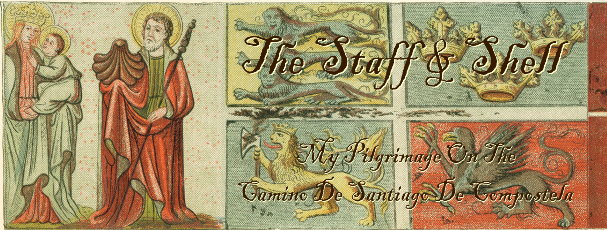Welcome Family & Friends
“Never lose an opportunity of seeing anything that is beautiful; for beauty is God's handwriting ~ a wayside sacrament. Welcome it in every fair face, in every fair sky, in every fair flower, and thank God for it as a cup of blessing."
~ Ralph Waldo Emerson
Last year as I was contemplating my 40th year on this big blue planet, that I have not seen nearly enough of, I thought that it was time to set some firm goals for myself rather than constantly saying “Wouldn’t it be nice to one day…”. Instead of having another blowout birthday bash, I have decided to opt for something a little more introspective. So, that’s it. 2011 is the year I’m doing my Pilgrimage on The Camino De Santiago De Compostela.
Why have I waited so long? Well to be truthful, I really had not heard about it until recently. I actually happened upon the idea watching an episode of "Burt Wolf's Travels & Traditions" on PBS one weekend. Then there's also the finances associated with such a long journey rife with logistics. This endeavor isn’t going to be cheap when you add up plane fare, hiking equipment, 50 euros a day, and time off from work. But my plans are slowly materializing. It’s going to happen - I can see it! I've even asked my friends and family to keep me to my word on this one. I plan on starting my trek in late September during the less congested season. If all goes well, I should end my journey close to the end of October 2011!
I created this blog to keep you all informed on my progress in the months leading up to my trip. This blog will give me a forum to educate everyone about the Pilgrimage and its history...and even comment on the French and Spanish cultures. I also plan on doing a lot of fundraising to help me pay for things I will need, so check back often as I announce events and opportunities for you to help me reach my goals. Speaking of goals, I will also be doing a lot of physical training to ready my body for the long walk. I will be sure to post all my trials and tribulations here as well. I know a lot of you will get a kick out of hearing how I "get back into shape" over the next few months. Please don't hold back if you have any tips that will aid in my fitness.
I will also utilize this blog to diary and chronicle my days while on the Pilgrimage. It will be my main mode of communication since I will be all the way in Spain. I will try and post daily musings of my travels, send out pretty pictures of the contryside, and tell you about all the wonderful people I encounter along the way. My path will take me across 350+ miles of beautiful landscapes starting near the Pyrenees and traversing all the way out to the Galician coast. I’m figuring on 4-5 weeks to reach the Cathedral where the remains of Saint James The Greater rest - I know, can you believe it?!!!
So thanks for visiting my blog! Please come by and poke around as I send out future updates and please spread the word - I want to share this story with everyone and anyone that is willing to listen and learn!
"What lies behind us and what lies before us are tiny matters compared to what lies within us."
Love Always,
Richert Gordon
The Power Of Myth :: An elaboration on the significance of the scallop shell and the pilgrim's staff.
 The scallop shell, typically found on the shores in Galicia, has long been the symbol of the Camino de Santiago. Over the centuries the scallop shell has taken on mythical, metaphorical and practical meaning.
The scallop shell, typically found on the shores in Galicia, has long been the symbol of the Camino de Santiago. Over the centuries the scallop shell has taken on mythical, metaphorical and practical meaning.
There are different accounts of the mythical origin of the symbol. Which account is taken depends on who is telling the story. Two versions of the most common myth are:
James the Greater, the brother of John, was killed in Jerusalem for his convictions about his brother. James had spent some time preaching on the Iberian Peninsula.
(version 1) After James' death, his disciples shipped his body to the Iberian Peninsula to be buried in what is now Santiago. Off the coast of Spain a heavy storm hit the ship, and the body was lost to the ocean. After some time, however, the body washed ashore undamaged, covered in scallops.
(version 2) After James' death his body was mysteriously transported by a ship with no crew back to the Iberian Peninsula to be buried in what is now Santiago. As James' ship approached land, a wedding was taking place on the shore. The young bridegroom was on horseback, and on seeing the ship approaching, his horse got spooked, and the horse and rider plunged into the sea. Through miraculous intervention, the horse and rider emerged from the water alive, covered in seashells.
Besides being the mythical symbol, the scallop shell also acts as a metaphor. The grooves in the shell, which come together at a single point, represent the various routes pilgrims traveled, eventually arriving at a single destination: the tomb of Saint James in Santiago de Compostela. The scallop shell is also a metaphor for the pilgrim. As the waves of the ocean wash scallop shells up on the shores of Galicia, God's hand also guided the pilgrims to Santiago.
The scallop shell served practical purposes for pilgrims on the Camino de Santiago as well. The shell was the right size for gathering water to drink or for eating out of as a makeshift bowl. Also, because the scallop shell is native to the shores of Galicia, the shell functioned as proof of completion. By having a scallop shell, a pilgrim could almost certainly prove that he or she had finished the pilgrimage and had actually seen the "end of the world" which at that point in history was the Western coast of Spain.
The reference to St. James rescuing a "knight covered in scallops" is therefore a reference to St. James healing, or resurrecting, a dying (setting sun) knight. Note also that the knight obviously would have had to be "under the waters of death" for quite some time for shellfish to have grown over him. Similarly, the notion of the "Sea of Darkness" (Atlantic Ocean) disgorging St. James' body, so that his relics are (allegedly) buried at Santiago de Compostella on the coast, is itself a metaphor for "rising up out of Death", that is, resurrection.
The pilgrim's staff is a walking stick used by pilgrims to the shrine of Santiago de Compostela in Spain. Generally, the stick has a hook on it so that something may be hung from it. The walking stick sometimes has a cross piece on it.
 The scallop shell, typically found on the shores in Galicia, has long been the symbol of the Camino de Santiago. Over the centuries the scallop shell has taken on mythical, metaphorical and practical meaning.
The scallop shell, typically found on the shores in Galicia, has long been the symbol of the Camino de Santiago. Over the centuries the scallop shell has taken on mythical, metaphorical and practical meaning.





























No comments:
Post a Comment